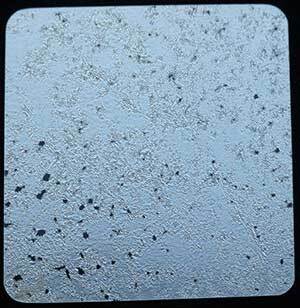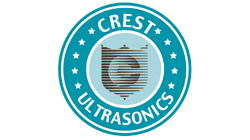How to Run Performance Checks on your Ultrasonic Cleaner
|
Let Us Help We can help you
find the perfect storage unit for your needs and budget. |
How do you know your ultrasonic cleaner is working "as advertised?" It "cleans" but is it delivering the performance it was designed to deliver when you purchased it? This post provides
- Performance checking exercises
- Tips to keep your cleaner working at peak performance
Establish your Ultrasonic Cleaner's Performance Benchmark
Checking the performance of your ultrasonic cleaning machine makes sense right from the beginning. By doing so and keeping records (just as your physician and auto service department do) you'll have a benchmark to which you can compare results of subsequent tests.
Here are three methods to establish performance benchmarks.
1. The Foil Test

A widely accepted means to establish a performance benchmark is called the "foil test." It is simple, very effective, and should be initiated as soon as you place your new unit in service. This provides you with a baseline that allows you to monitor performance on an ongoing basis.
Conduct this test with a freshly prepared and degassed cleaning solution formulation that you regularly use in your operations, and at the solution temperatures you normally use.
- Cut 3 strips of regular (not heavy-duty) household aluminum foil
- Suspend them in the cleaning solution by hanging them over a wire – one in the center and the others at each end, but not touching the tank walls or bottom. This placement lets you test the efficacy of transducers bonded to the cleaning tank.
- Activate the ultrasound. In a few minutes all foil sheets should display evidence of significant pitting, indicating that the cleaner is working properly.
- Retain the strips in a plastic sleeve marked with the date, the parameters of the test including time, temperature, solution, and any other relevant settings (e.g. power level, ultrasonic mode), and the ultrasonic cleaner model and serial number to compare results with future tests that you should schedule on an annual basis.
2. The Pencil Test
The pencil test can be performed with a frosted glass and a No. 2 pencil.
Draw an X on the frosted glass connecting the corners. Immerse the glass in the tank and activate the ultrasound. Record and save the time it takes for the X to disappear. This provides the benchmark for future tests.
3. The OK-Sonic™ Ultrasonic Bath Monitor
The OK-Sonic Bath Monitor is designed principally for testing units used for cleaning medical and dental instruments. It consists of indicator strips that monitor integrated results of the cleaning process parameters including strength of cavitation, exposure time and temperature.
Each monitor consists of two blue protein mixture soil spots on a plastic substrate. One spot is exposed and one covered by the holder. These represent open surfaces and less exposed difficult-to-clean parts of instruments.
When placed in a cleaner, the blue soil is slowly removed by cavitation in the cleaning bath. A detergent cleaning solution such as biodegradable MedClean C7 is recommended to expedite this process. Spots wash off completely from the substrate when exposed to sufficient cleaning cycle parameters. For more information, check the post on OK-Sonic Bath Monitors.
Performance Checking Ultrasonic Cleaner Operating Features
Basic ultrasonic cleaners have a simple on-off switch. Advanced models offer a range of features that can be checked on a regular basis. For example:
- Check the actual temperature of the cleaning solution against the set temperature on a regular basis. Set the bath temperature to 35°C and set the cleaning time to 15 minutes. Start the ultrasonic power and once the solution has reached the set temperature turn the unit off and use a calibrated digital thermometer to get an independent reading. This temperature should not deviate from the set temperature by more than 2 - 3˚C. If excess deviations continue to occur contact the supplier or manufacturer. Note that the displayed temperature should not deviate from the temperature measured with a calibrated thermometer by more than ±2%.
- Check timer accuracy on a monthly basis. Set the timer for 15 minutes and switch on the unit. Use a stopwatch to measure any deviation. It should be less than 5% (45 seconds). If results are not satisfactory contact the manufacturer.
- Check power consumption on a regular basis.Use a wattmeter between the unit plug and the wall outlet. Operate the tank without the heater on. The wattmeter reading should not deviate from the unit’s operating instructions power by more than ± 15%. If cleaning is satisfactory you can run the unit at lower power but inspect results more thoroughly.
Spotting Signals of Performance Problems
An absence of hissing and wave action results in slow or ceased cleaning. An electronic malfunction may be the cause. First try a reset by turning off the unit and disconnecting it from the power source. If reconnecting does not solve the problem or the malfunction continues to occur, return the unit to an authorized service point or manufacturer for repair.
Malfunctioning transducer systems can be indicated by a complete system breakdown in which case the generator turns off and all control panel diodes go dark. The unit should be returned to an authorized service point or manufacturer.
Note that iUltrasonic honors all product warranties offered by manufacturers of products we sell.
5 Points to Avoid Decreased Performance
Establish and follow a set of standard operating procedures
You'll find guidelines in the ultrasonic cleaner manufacturer’s operating and maintenance instructions.
1. Always degas fresh cleaning solutions.
Degassing drives off cavitation-inhibiting trapped air; the amount of time required depends on the volume of the cleaning tank.
Degassing is accomplished by activating the degas mode (if so equipped) or operating the unit without a load. A uniform hissing sound, absence of large bubbles and a "blurred" solution surface indicates a degassed solution.
2. Clean at the recommended temperature.
This is provided by the cleaning solution manufacturer. Remember that as the unit operates the temperature of the cleaning solution will increase due to ultrasonic energy. It can reach 60˚C (140˚F) or higher. If higher cleaning temperatures are required, the ultrasonic cleaner’s heater thermostat can be set accordingly.
If high temperatures can damage the products the installation of a cooling coil attached to an external chilled water supply is recommended.
3. Monitor cleaning solution levels in the tank.
Each time you remove a basket of cleaned parts you remove solution coating the parts. Heat causes evaporation, which can be slowed by covering the tank during operation. This will also muffle noise. Damage can result when the tank is operating at less than capacity (either to the “fill” line or 2/3 full). Overfilled tanks will not clean satisfactorily.
4. Extend Cleaning Solution Effectiveness.
Dirt and contaminants removed during ultrasonic cleaning remain in the solution. Over time they build up and reduce cleaning solution effectiveness. Extending cleaning solution life can be done in several ways.
A good practice is skimming off oils and other contaminants that rise to the surface. This also helps avoid contaminants adhering to cleaned products as they are removed from the bath. Some industrial-sized ultrasonic cleaners are equipped with skimmers; otherwise it is a manual process. Solution filters are also available to remove suspended solids in industrial sized equipment.
For more details on this important point see Extending Cleaning Solution Performance.
When it is time to change the solution it must be drained and disposed of according to local regulations.
5. Cleaning Tank Maintenance
Before replacing the cleaning solution, take the time to thoroughly clean the tank following procedures in the user manual. This removes settled solids that will eventually cause serious damage.
Look for scaling or rust deposits that result from hard water or items that have been cleaned. Remove these by following the manufacturer's tank cleaning procedures.
Carefully vacuum or brush away dust that accumulates at the grill covering the unit's cooling fan.
Need More Help on Performance Checking your Ultrasonic Cleaner?
Contact the professionals at iUltrasonic for advice, and for unbiased assistance in selecting an ultrasonic cleaner, cleaning solution formulations and cleaning procedures designed to meet your specific requirements.






